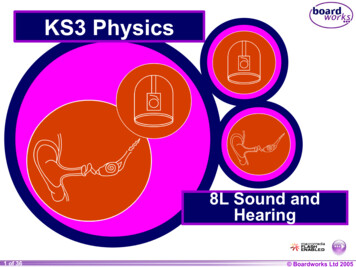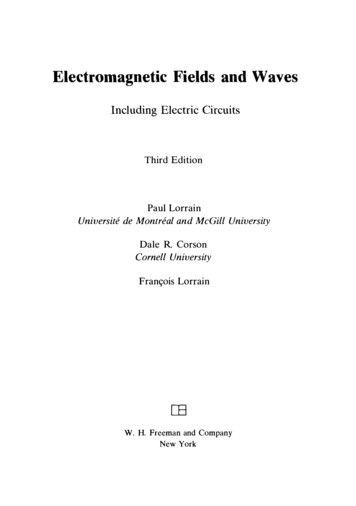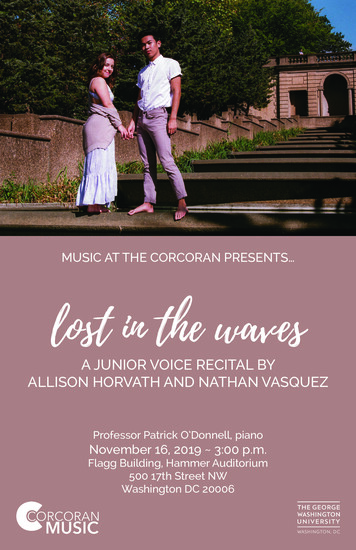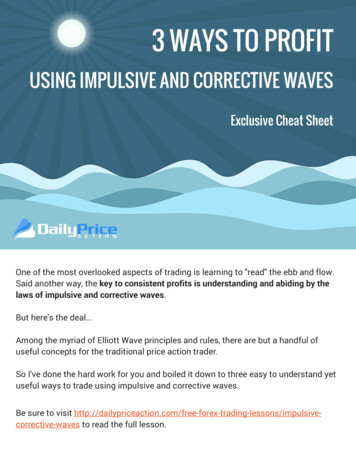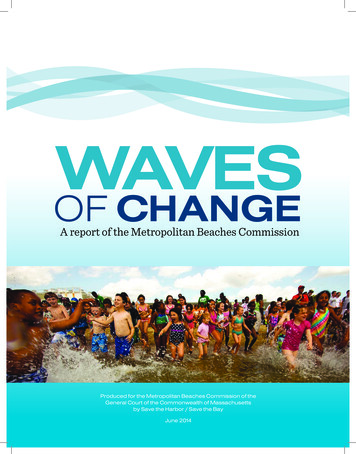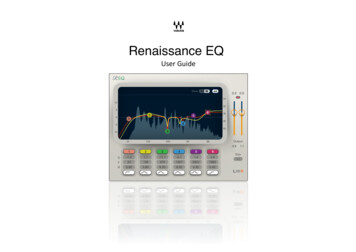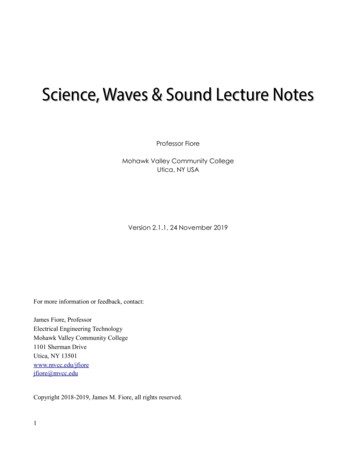
Transcription
Science, Waves & Sound Lecture NotesProfessor FioreMohawk Valley Community CollegeUtica, NY USAVersion 2.1.1, 24 November 2019For more information or feedback, contact:James Fiore, ProfessorElectrical Engineering TechnologyMohawk Valley Community College1101 Sherman DriveUtica, NY 13501www.mvcc.edu/jfiorejfiore@mvcc.eduCopyright 2018-2019, James M. Fiore, all rights reserved.1
Table of Contents1. The Scientific Method .32. Facts Versus Theories .53. Cognitive Bias and Logical Fallacies .64. Scientific Notation.95. The Metric System.116. Introduction to Waves .147. Simple Harmonic Motion and Resonance .188. Pitch, Frequency, Overtones, Timbre and All That Stuff.239. Human Hearing .2510. Basic Acoustics .3211. Loudspeakers and Microphones.3612. Digital Audio.4313. Musical Scales and Temperament. .502.
1 The Scientific MethodThe scientific method is a means of uncovering and explaining physical phenomena. It relies on observation andlogical reasoning to achieve insight into the actions and relations of the phenomena, and a means of relating it tosimilar items. The method starts with observations and measurements. Based on these and backgroundknowledge such as mathematics, physics, the behavior of similar phenomena, and so on, a tentative explanation,or hypothesis, is derived. The hypothesis is then tested using experimental or field data. The precise nature of thetests depend on the area of study, but the idea will always be the same: namely to see if the predictions of thehypothesis are borne out under alternate applicable conditions or data sets. A proper hypothesis must be testableand falsifiable. That is, the hypothesis must be able to be proven wrong by subsequent observation. If it is not,then the hypothesis is better classified as philosophy. For example, Newtonian gravitation could be proven falseby letting go of a suspended hammer and watching it remain motionless or fall upwards, rather than fall downtoward the Earth. Similarly, Evolution could be proven false by the discovery of “fossil rabbits in thePrecambrian”, to quote famous biologist J. B. S. Haldane (Haldane was being somewhat snippy, but in general,he meant anything that would be clearly out of the expected time-line, in this case a small mammal predatingeven the most simple creatures with backbones).A hypothesis is tested by repeated cycles of prediction, observation and measurement, and also subject to peerreview, that is, the critique of others in the field of study who may point out inconsistencies in the explanationsor logic, errors in experimental design, and so on. This cycle continues until the weight of data and scientificopinion elevates the hypothesis to a theory. One might say that a theory is a hypothesis that has withstood therigors of the scientific method. This cycle was well expressed by the Marquise du Châtelet 1. She explainedhypotheses as “probable propositions”. While it would only take one observation to falsify a hypothesis, severalwould be required to vindicate it: “each non-contradictory result would add to the probability of the hypothesisand ultimately we would arrive at a point where its ‘certitude’ and even its ‘truth’, was so probable that wecould not refuse our assent”.It is important to note that the scientific usage of the word theory is entirely different from its popular usage,which is perhaps closer to hunch or seat-of-the-pants guess. Also, a scientific theory is not true in the samesense as a fact. Facts come in three main varieties: direct and indirect observations; and those that may belogically deduced. A direct observation is something that you have measured yourself, such as noting the time ittakes for a ball to reach the ground when released from a given height. An indirect observation is something thatmay be inferred from other known quantities or proper historical data, such as “George Washington was the firstpresident of the United States of America”. An example of the third variety would be “If x is an even integerlarger than four and smaller than eight, then x must be six”. At first glance, it may seem that facts are highest onthe pecking order, but scientific theories are much more useful than facts because isolated facts have very littlepredictive capacity. It is the predictive and explanatory ability of theories that make them so powerful.13Du Châtelet was that most rare of 18th century women: a mathematician and physicist. She translated Newton’sPrincipia Mathematica into French and was also the lover of Voltaire. Unfortunately, after an affair with the poet JeanFrançois de Saint-Lambert in her early 40s, she became pregnant and died six days after giving birth.
So a theory is a best estimate so far, a model to explain some observable aspect of the universe. It is understoodthat as our view of what is observable widens and our knowledge extends, so too a given theory may be refined.A good example is Newtonian Gravitation. This model was sufficient to describe the movements of the planetsaround the sun and is still used to plan the flight of space craft. In the early 1900s, however, Einstein’s Theory ofRelativity refined Newtonian Gravitation to include more extreme (relativistic) effects. It is important to notethat we did not throw out Newton’s equations; rather, we now have a better understanding of the set ofconditions under which they apply. While this trek towards more and more refinement is not truth in and ofitself, to paraphrase the late Harvard paleontologist, Stephen Jay Gould, to ignore the weight of scientific databehind an established theory would be perverse.4
2 Facts Versus TheoriesPonder the following query: “If a fact is fundamentally true, isn’t it better than a theory?”At first glance, it may appear that a fact is more valuable than a theory because the former is, by definition, trueand unchangeable. The reality is that theories are much more useful to us than individual, isolated facts.Consider the following. Suppose you hold out a stone at arm’s length and let go. It drops to the ground. That’s afact. You saw it happen. Unfortunately, by itself, it doesn’t tell you very much. Suppose you repeat this severaltimes and each time the stone drops in precisely the same way as it did initially. This is beginning to get usefulbecause you’re noticing a pattern, and patterns can be predictive. Now, suppose you pick up stones of differingsizes, say 100 grams, 200 grams, half a kilogram and a kilogram, and drop each of them in turn. You observethat they each hit the ground in the same amount of time. Further, you drop them from different heights and younotice that the higher up they are, the longer it takes for them to hit the ground, but they all take the sameamount of time to reach the ground.You might now formulate a hypothesis: namely that the mass of a stone doesn’t have an affect on how fast itfalls from a given height and that height and fall time are directly related. Your hypothesis is predictive.Although you used only four sizes of stones and a few heights, your broadened hypothesis should apply to anystone dropped from any height. So now you (and a bunch friends) starting picking up random pairs of stones anddrop them from random heights, and sure enough, you see the same effect again and again. If you do thisenough and it is continually verified without exception, you might even make a “law of falling stones”,particularly if you were able to quantify the times and heights through careful measurement and reduce therelation to a nice formula. It is useful because you can now predict what will happen with any stone droppedfrom any height. But this law is rather limited. It only applies to stones because you may have noticed thatstones drop much faster than pieces of cork. While you might then proceed to make a “law of falling cork”, thatwould unnecessarily complicate things. Instead, you could take a step back and try to figure out why stones andcork both fall, but not at the same rate. Eventually, you might discover that the difference has to do with airfriction and you can now create a law governing falling bodies in a frictionless environment. That’s even moreuseful than the original “law of falling stones”.But even this new and improved “law of falling bodies” doesn’t offer a lot of insight into what is really going onin the larger scheme of things. Through repeated observations and experiments this could be extended to covernot just falling bodies on the earth, but the interactions between any bodies, including falling stones and cork onthe moon, or the interaction between the earth and the sun, the sun and the other planets, the sun and other stars,and so on. What you’ll have arrived at is a full-blown theory of gravitation (Newtonian gravitation). Now that isan extremely useful tool. It helps us design airplanes, get satellites into orbit, even get people to the moon andback safely.5
3 Cognitive Bias and Logical FallaciesAs humans, we need to recognize that we are fallible. No matter how good our intentions, we make mistakesand can be fooled. The first step toward reducing and ultimately eliminating these sources of error is tounderstand them. We will lump these into two broad categories: cognitive bias and logical fallacies.Cognitive BiasA cognitive bias is an inclination toward looking at a situation in an unbalanced or unfair manner. Generally,people are not aware of these biases. One example is confirmation bias (AKA, confirmation of expectedoutcomes). That is, we expect (or hope) to see a certain result and thus we tend to overvalue evidence thatconfirms it while discounting evidence that contradicts it. One way to avoid this is through the use of a doubleblind test. Suppose we wish to test a new drug to see if it is effective and safe. As we may have invested a lot oftime and money developing the drug, it is only natural that we want it to work, and this may skew our analysis(unintentionally, of course). What we do is have a third party create two sets of pills; one is the drug under testand the other is a placebo (it looks like the other pill but does nothing). These sets are identified using codesknown only to the third party. The sets are then given to the researchers who, in turn, give them to the patients.The important thing is that neither the patients nor the researchers know which pills are which. When the trialhas run its course, the researchers (us) analyze the data to determine if any set of pills was successful. Only afterthe analysis is completed does the third party tell the researchers which set was real and which set was theplacebo.Another cognitive bias is the Dunning-Kruger effect, named after the two social psychologists who studied it.This states that the knowledge needed to determine if someone is competent in a certain field is competence inthat same field. Thus, individuals who have low competence are not in a position to accurately evaluate theirown level of competence. Consequently, these individuals often over estimate their competence. This is knownas illusory superiority. To put it crudely, these individuals are too ignorant of the subject to understand just howignorant they are. Among the highly competent, two other effects may be seen. First, the advanced individualmay be keenly aware of any shortcomings or gaps in their competence and may undervalue their level as aresult. Second, they may assume that their level of competence is typical, and that most people are therefore “attheir level”.It is useful to remember that in our increasingly complex and interdependent society, no one can be an expert ateverything, or even at most things. Instead, it is likely that we are all largely ignorant of a majority of subjectsand /or incompetent at a variety of skills.6
Logical FallaciesLogical fallacies represent faulty reasoning. They are “thinking traps” that people sometimes fall into.Familiarity with them will help reduce their occurrence. There are dozens of logical fallacies but we shall onlyinvestigate a representative few.To help explain the process, we'll begin with a syllogism. This is, in essence, a simple argument. It starts with amajor premise (a generalization) which is followed by a minor premise (a more specific statement). From these,we derive a conclusion. For example:All humans breathe air.Alice is a human.Therefore, Alice breathes air.(major premise)(minor premise)(conclusion)Errors can occur when either premise is false or when the conclusion does not follow (the latter being referred toas a non-sequitur). For example:All fish live in water.Lobsters live in water.Therefore, lobsters are fish.The problem with this is the linkage between the major and minor premises. Saying “all fish live in water” doesnot preclude something else (like a lobster or a sea snake or kelp) from living in water. Compare the priorexample to this version:All fish live in water.Trout are fish.Therefore, trout live in water.While these examples may seem obvious, there are trickier versions. For example:I am made of nothing but atoms.Atoms are not alive.Therefore, I am not alive.Nope. Doesn't work. This error is called the fallacy of composition. Basically, it says that what is true of theparts must be true of the whole, and vice versa. It ignores the concept of emergent properties (consider thebehavior of a single bird to a flock, or a single fish to a school).The fallacy of composition can be illustrated without using a syllogism. Suppose you are in a crowded movietheater. If you stand up, you will have a better view of the screen. In contrast, it is not true that if everyonestands up, everyone will have a better view. In fact, everyone will most likely have a worse view. If one personstands, they are unique. That unique character is lost when everyone stands.7
Turning to a different fallacy, the latin phrase post hoc ergo propter hoc can be translated as “Be
So a theory is a best estimate so far, a model to explain some observable aspect of the universe.It is understood that as our view of what is observable widens and our knowledge extends, so too a given theory may be refined.



